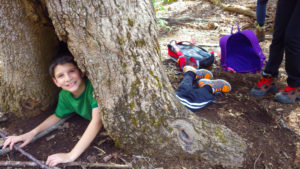
The humidity today is hovering around ninety percent and the temperature on the ridgeline feels right about the same. I, nine students, and another teacher are in the process of getting cooked as we make our way down the trail. The gentle murmuring of students and the occasional rock being innocently (or not so innocently) kicked down the hill lull us into a healthy sense of familiarity.
I’ve been with these students for two days already, today being the last before their teachers take them back to a classroom two hours away from here. The field trip they’ve been looking forward to since third grade has come and is about to pass.
Three days is hardly enough.
I still remember the day they arrived, barely willing to sit on the ground for fear of getting the tiniest smudge of dirt on their pants. Today I’m pretty sure I can see some leftover mud on at least one boy’s face from the day prior. To me, that means things are going well. It means that I’m doing my job.
As we get closer to our destination, I can hear the murmuring get louder in direct proportion to the noise of the water.
“I hear it!” they mutter.
“We’re almost there.”
“I can smell it!”
As we turn the final corner, all of these phrases and more congeal into one shared sentiment: “Whoa.”
There’s a question that I often ask students when I first meet them. Sometimes it’s during the first day of a field trip to the Great Smoky Mountains Institute at Tremont, other times it’s towards the end of the week. Sometimes I even do it during lunch. At any rate, it’s a question that I’d like to pose to you now as well:
Have you ever met a tree?
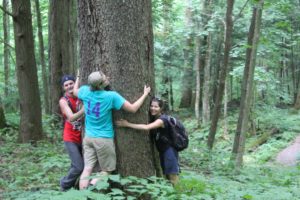
You’ve seen one, of course. You’ve seen hundreds of them, thousands of them, millions of them. But have you ever met one before? The same way you meet a person; walk up, shake their hand, observe their features, maybe just give them a hug if you’re anything like me.
So I want you to try something for me.
Grab a towel, a bandana, or something along those lines, grab your kids, and go outside to a spot with a bunch of trees.
Go on, I’ll wait.
Seriously, I’m waiting.
Once you get outside, I want you to pick one of your kids and blindfold them with that towel or bandana. Spin them around three times and guide them to a nearby tree using only your voice. Make sure to warn them about roots!
Now ask them to meet this tree. Use their senses. Say they can rub their hands up and down the bark; what does it feel like? Is it leathery or chunky or flaking off in your hand? Smell it. Is it earthy? Spicy? Piney? Go ahead and tap it a couple times; how does it sound? Is it hollow? Solid? Maybe it’s even a little bit softer than you thought. And of course, if you are so inclined, go ahead and give it a good lick.
Now take them away from that tree, blindfold still on.
Bring them back to where they started and ask your child to go out and find that tree.
Can they do it?
Could you do it?
Go for it. Switch up the roles. It’s okay, I can wait. I’m just a bunch of words in a magazine anyway.
So tell me, dearest reader, how do you feel? Do you really want to know why that tree had those weird shaped holes in it? Do you need to know why it smells like Christmas? Are you struggling to come up with a tree species so you can give it a proper relevant name?
Guess what, I’ve just made you emotionally invested in that tree without lecturing to you about it.
That’s what I do. I’m something called an Outdoor Educator (or a Naturalist) and it’s my job to help you (yes you!) get outside and see things in a way you’ve never seen them before. To get people to learn new things and get really excited about the same things that get me excited.
It’s a great job, but it’s often a hard job.
One of the first things a great many students as me when arriving at Tremont is why their cell phone doesn’t work. Well, it doesn’t have service. And then they give me this look:
You mean… there are places cell phones don’t work? That’s possible?
And I use the term student for a reason; it’s not just the kids.
You mean… I can’t check my email? You don’t have cable? You don’t know what the weather is going to be for the next seven days down to the minute?
Is that healthy?
There is a lot of research coming through academia that argues it is not healthy. Lack of exposure to the outdoors can cause attention disorders, a decrease in creative play, and can indirectly contribute to obesity.
But I’m a fan of the direct approach.
I have a challenge for you. If you didn’t go out and meet a tree before, when I asked you oh so nicely, I would like you to take your children outside and try it for half an hour. Thirty minutes, that’s it.
Then go inside and sit on your smartphone for thirty more.
Which feels healthier?
The waterfall blew them all away.
It always does, and I hope that it always will.
As I gather the students back up to head towards campus, some are still riding the high of their first waterfall, and others are solemn and weary about the trip home. Tomorrow morning they wake up, eat breakfast, hop on the bus, and I may never see them again.
I’ve worked with thousands of students from dozens of states, and only a few have made reappearances in my life in days and months following. So I’ll wave goodbye, I’ll issue farewells that would seem to a casual observer far too deep for just a few days together, and I’ll be happy.
Because no matter where they go, no matter what they do next…
They’ll always have the outdoors.


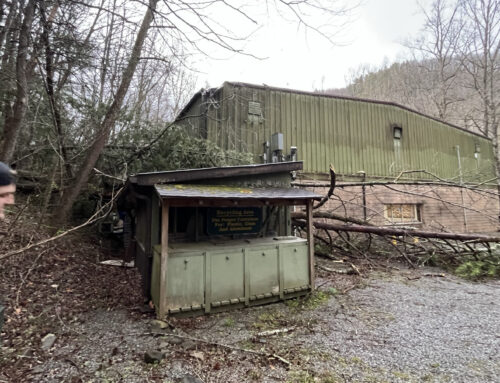
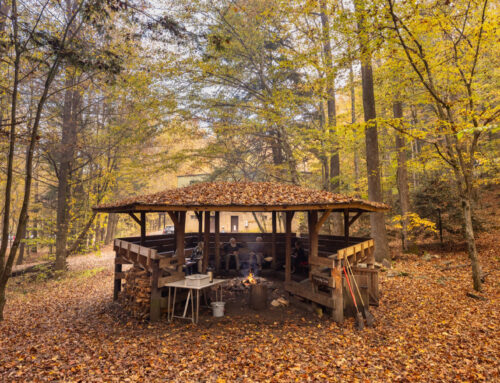
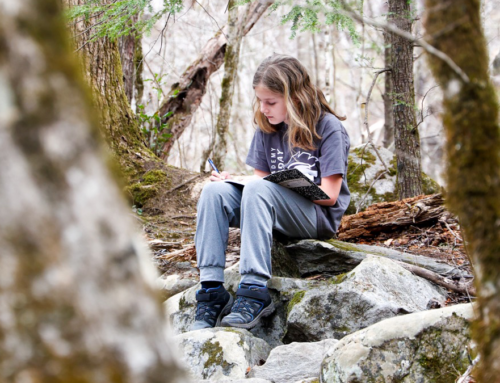
![A Deep Dive Into Wetlands [Free Lesson Plan]](https://gsmit.org/wp-content/uploads/2024/02/madeline-blog-cover-500x383.png)
